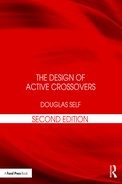Book Description
The use of active crossovers is increasing. They are used by almost every sound reinforcement system, and by almost every recording studio monitoring set-up. There is also a big usage of active crossovers in car audio, with the emphasis on routing the bass to enormous low-frequency loudspeakers. Active crossovers are used to a small but rapidly growing extent in domestic hifi, and I argue that their widespread introduction may be the next big step in this field.
The Design of Active Crossovers has now been updated and extended for the Second Edition, taking in developments in loudspeaker technology and crossover design. Many more pre-designed filters are included so that crossover development can be faster and more certain, and the result will have a high performance. The Second Edition continues the tradition of the first in avoiding complicated algebra and complex numbers, with the mathematics reduced to the bare minimum; there is nothing more complicated to grapple with than a square root.
New features of the Second Edition include:
● More on loudspeaker configurations and their crossover requirements:
MTM Mid-Tweeter-Mid configurations (The d'Appolito arrangement)
Line arrays (J arrays) for sound reinforcement
Frequency tapering
Band zoning
Power tapering
Constant-Beamwidth Transducer (CBT) loudspeaker arrays
● More on specific sound-reinforcement issues like the loss of high frequencies due to the absorption of sound in air and how it varies.
● Lowpass filters now have their own separate chapter.
Much more on third, fourth, fifth, and sixth-order lowpass filters.
Many more examples are given with component values ready-calculated
● Highpass filters now have their own separate chapter, complementary to the chapter on lowpass filters.
Much more on third, fourth, fifth, and sixth-order highpass filters.
Many more examples are given with component values ready-calculated
● A new chapter dealing with filters other than the famous Sallen & Key type. New filter types are introduced such as the third-order multiple feedback filter.
There is new information on controlling the Q and gain of state-variable filters.
● More on the performance of crossover filters, covering noise, distortion, and the internal overload problems of filters.
● The chapter on bandpass and notch filters is much extended, with in-depth coverage of the Bainter filter, which can produce beautifully deep notches without precision components or adjustment.
● Much more information on the best ways to combine standard components to get very accurate non-standard values. Not only can you get a very accurate nominal value, but also the effective tolerance of the combination can be significantly better than that of the individual components used. There is no need to keep huge numbers of resistor and capacitor values in stock.
● More on low-noise high-performance balanced line inputs for active crossovers, including versions that give extraordinarily high common-mode rejection. (noise rejection)
● Two new appendices giving extensive lists of crossover patents, and crossover-based articles in journals.
This book is packed full of valuable information, with virtually every page revealing nuggets of specialized knowledge never before published. Essential points of theory bearing on practical performance are lucidly and thoroughly explained, with the mathematics kept to an essential minimum. Douglas' background in design for manufacture ensures he keeps a very close eye on the cost of things.
